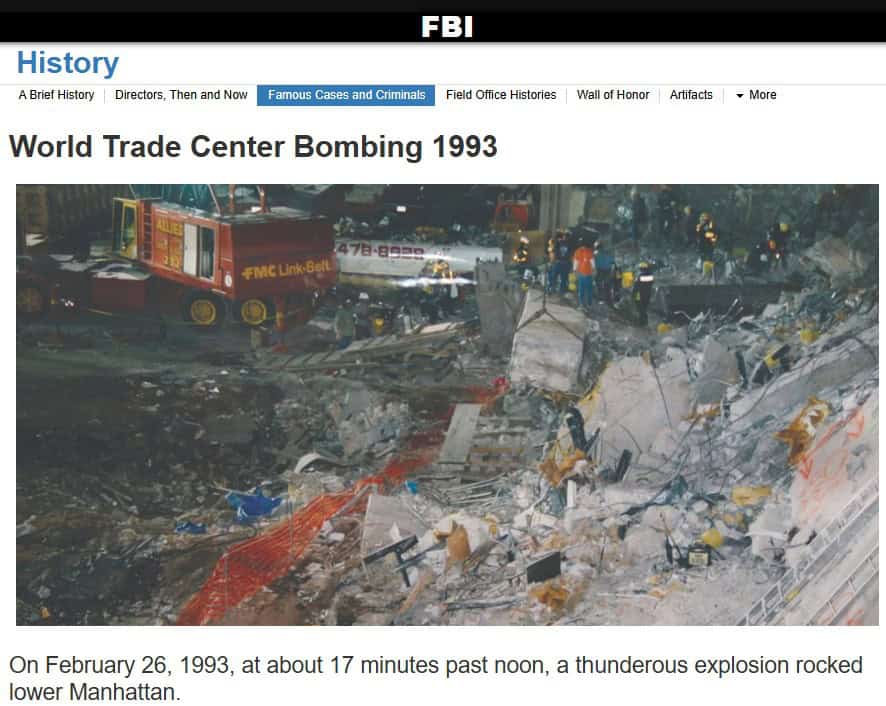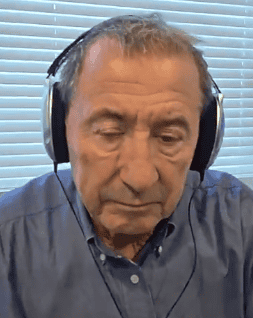Click Here For Link To Official FBI Report: World Trade Center Bombing 1993 — FBI
Two of the FBI agents who investigated the 1993 bombing of the World Trade Center were born and raised in Atlantic City. One was John P. O’Neill who was killed during the second attack on September 11, 2001. The other was Charles “Chuck” Stern. Click here for link to full 59 Page Oral History given by Stern in 2016: Stern, Charles- FINAL w Cover.pdf (socxfbi.org)
On February 26, 1993, at about 17 minutes past noon, a thunderous explosion rocked lower Manhattan.
The epicenter was the parking garage beneath the World Trade Center, where a massive eruption carved out a nearly 100-foot crater several stories deep and several more high.
Six people were killed almost instantly. Smoke and flames began filling the wound and streaming upward into the building. Those who weren’t trapped were soon pouring out of the building—many panic-stricken and covered in soot. More than a thousand people were hurt in some way, some badly, with crushed limbs.
Middle Eastern terrorism had arrived on American soil—with a bang.
As a small band of terrorists scurried away from the scene unnoticed, the FBI and its partners on the New York Joint Terrorism Task Force began staffing up a command center and preparing to send in a team to investigate. Their instincts told them that this was terrorism—they’d been tracking Islamic fundamentalists in the city for months and, they’d later learn, were tantalizingly close to encountering the planners of this attack. But hunches weren’t enough; what was needed was definitive proof.
They’d have it soon enough. The massive investigation that followed—led by the task force, with some 700 FBI agents worldwide ultimately joining in—quickly uncovered a key bit of evidence. In the rubble investigators uncovered a vehicle identification number on a piece of wreckage that seemed suspiciously obliterated.
A search of our crime records returned a match: the number belonged to a rented van reported stolen the day before the attack. An Islamic fundamentalist named Mohammad Salameh had rented the vehicle, we learned, and on March 4, an FBI SWAT team arrested him as he tried in vain to get his $400 deposit back.
One clue led to another and we soon had in custody three more suspects—Nidal Ayyad, Mahmoud Abouhalima, and Ahmed Ajaj. We’d also found the apartment where the bomb was built and a storage locker containing dangerous chemicals, including enough cyanide gas to wipe out a town. All four men were tried, convicted, and sentenced to life in prison.
The shockwave from the attack continued to reverberate. Following the unfolding connections, the task force soon uncovered a second terrorist plot to bomb a series of New York landmarks simultaneously, including the U.N. building, the Holland and Lincoln Tunnels, and the federal plaza where our office in New York is housed. On June 24, 1994, FBI agents stormed a warehouse in Queens and caught several members of a terrorist cell in the act of assembling bombs.
Meanwhile, the mastermind of the World Trade Center bombing was still on the run—and up to no good. We’d learned his name—Ramzi Yousef—within weeks after the attack and discovered he was planning more attacks, including the simultaneous bombing of a dozen U.S. international flights.
Yousef was captured in Pakistan in February 1995, returned to America, and convicted along with the van driver, Eyad Ismoil. A seventh plotter, Abdul Yasin, remains at large.
We later learned from Yousef that his Trade Center plot was far more sinister. He wanted the bomb to topple one tower, with the collapsing debris knocking down the second. The attack turned out to be something of a deadly dress rehearsal for 9/11; with the help of Yousef’s uncle Khalid Sheikh Mohammed, al Qaeda would later return to realize Yousef’s nightmarish vision.
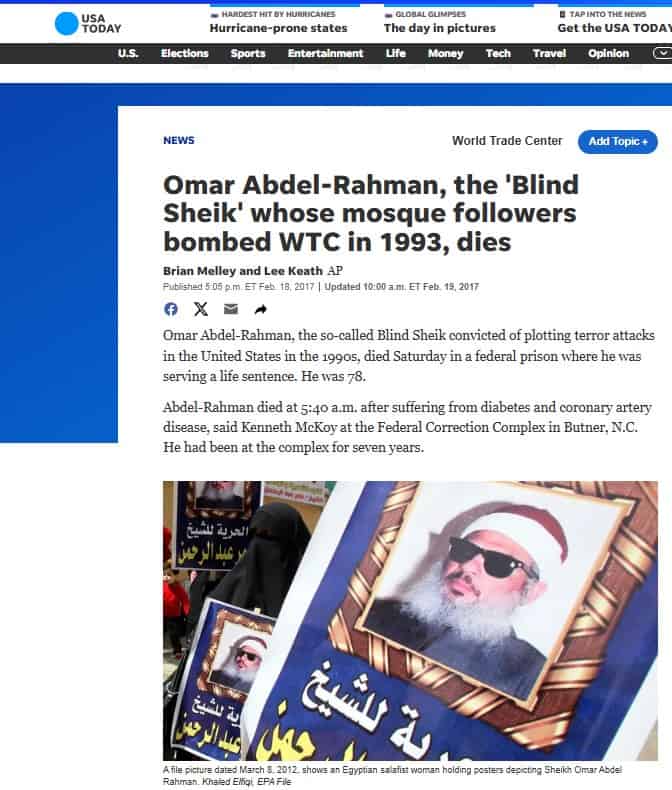
Click Here For Link To Full Post In USA Today: Omar Abdel-Rahman, the ‘Blind Sheik’ whose mosque followers bombed WTC in 1993, dies (usatoday.com)
Blind since infancy from diabetes, Abdel-Rahman was the leader of one of Egypt’s most feared militant groups, the Gamaa Islamiya, which led a campaign of violence aimed at bringing down ex-President Hosni Mubarak.
Abdel-Rahman fled Egypt to the U.S. in 1990 and began teaching in a New Jersey mosque. A circle of his followers were convicted in the Feb. 26, 1993, truck bombing of New York’s World Trade Center that killed six people — eight years before al-Qaida’s suicide plane hijackers brought the towers down.
Later in 1993, Abdel-Rahman was arrested by authorities who accused him and others of conspiring to wage a string of bombings against the United Nations and other New York landmarks, including the George Washington Bridge and the Lincoln and Holland tunnels.
Abdel-Rahman’s activities pre-dated Osama bin Laden’s formation of al-Qaida in the late 1990s. But he was an influential figure in the generation of Islamic extremists that emerged from Egypt over the past two decades.
While Abdel-Rahman was the spiritual leader of Gamaa Islamiya, his longtime associate from Egyptian militant circles, Ayman al-Zawahri, was a leader of the Islamic Jihad militant group, whose experienced fighters he later allied with bin Laden’s riches to form al-Qaida. Al-Zawahri is now leader of al-Qaida.
The two groups shared an ideology rejecting the governments of Egypt and other Arab countries as infidels that must be brought down by force. Between 1990 and 1996, they carried out a wave of attacks on Western tourists, Egyptian police and Coptic Christians until a heavy-handed government crackdown largely shattered them.
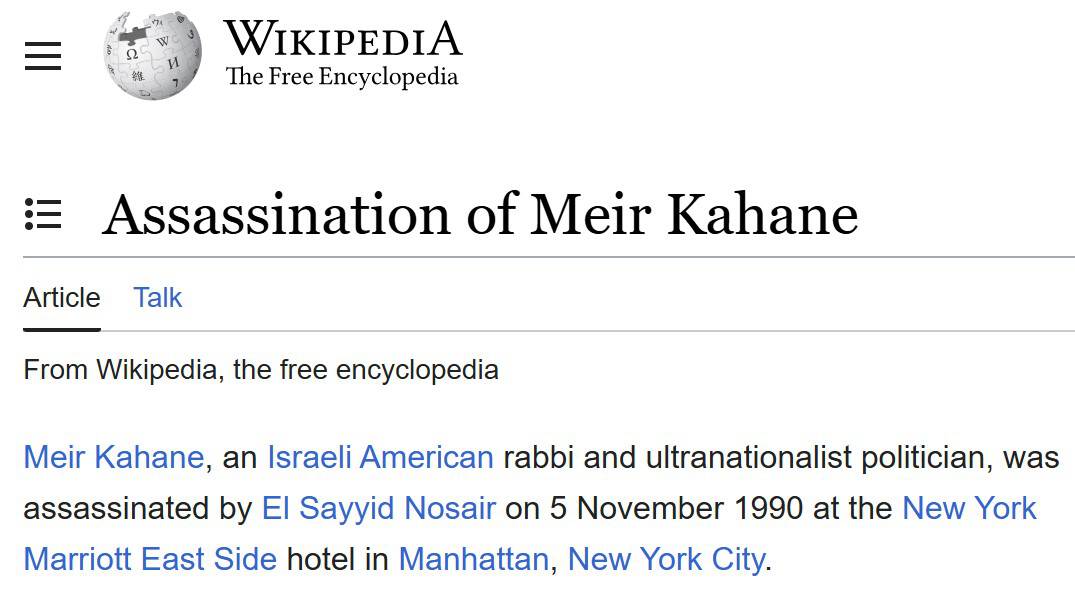
Click Here For Link To Full Wikipedia Article: Assassination of Meir Kahane – Wikipedia
On the evening of 5 November 1990, Kahane gave a speech in the second-floor lecture hall of the New York Marriott East Side hotel, in Manhattan, at 525 Lexington Avenue, to an audience, most of whom were Orthodox Jews. After his speech, a crowd of well-wishers gathered around Kahane as he answered questions. Shortly after 9:00 p.m., a man disguised as an Orthodox Jew approached Kahane and shot him from close range with a .357-caliber pistol.[1] Kahane was hit in the neck by the gunfire and died of his wounds shortly thereafter.[2][3][4]
After shooting Kahane, the assassin fled from the hotel and reached Lexington Avenue, where, in front of a post office, he attempted to take over a taxi at gunpoint. Carlos Acosta, an on-duty postal police officer, drew his pistol and ordered the assassin to freeze.[1] Instead, the assassin turned toward the officer and shot and hit him in the chest. The officer returned fire, hitting the assassin in the chin. Afterwards, the officer arrested the man. Born in Egypt, he was American citizen El Sayyid Nosair, who had been living in Jersey City, New Jersey.[1]
Conspiracy to free Nosair from prison
Nosair was to serve his sentence at Attica Correctional Facility, in New York. In 1993, the “Blind Sheikh,” Omar Abdel-Rahman, was arrested in New York. An investigation later revealed that a terrorist cell, led by Abdel-Rahman, conducted detailed surveillance of Attica facilities and that it had discussed plans to use a truck bomb attack, combined with an armed assault, to rescue Nosair from prison.[9][10]
Nosair’s confession of Kahane’s assassination
Several years after the 1993 World Trade Center bombing, Nosair made a confession to federal agents of assassinating Kahane.[11]
Click Here For Link To Full Wikipedia Article on Sheikh Omar Abdel-Rahman (“The Blind Sheikh”): Omar Abdel-Rahman – Wikipedia

Imprisonment in Egypt
[edit]
During the 1970s, Abdel-Rahman developed close ties with two of Egypt’s most militant organizations, Egyptian Islamic Jihad and Al-Jama’a al-Islamiyya (“The Islamic Group”). By the 1980s, he had emerged as the leader of Al-jama’a al-Islamiyya, although he was still revered by followers of Egyptian Islamic Jihad, which at the time was being led by Ayman al-Zawahiri, later to become the leader of al-Qaeda. Abdel-Rahman spent three years in Egyptian jails while awaiting trial on charges of issuing a fatwa resulting in the 1981 assassination of Anwar Sadat by Egyptian Islamic Jihad.[11]
Afghan Mujaheddin
[edit]
Although Abdel-Rahman was not convicted of conspiracy in the Sadat assassination, he was expelled from Egypt following his acquittal. He made his way to Afghanistan in the mid-1980s, where he contacted his former professor, Abdullah Azzam, co-founder of Maktab al-Khadamat (MAK) along with Osama bin Laden. Abdel-Rahman built a strong rapport with bin Laden during the Soviet–Afghan War and, following Azzam’s murder in 1989, he assumed control of the international jihadist arm of MAK/Al Qaeda.[citation needed]
In July 1990, Abdel-Rahman traveled to New York City to gain control of MAK’s financial and organizational infrastructure in the United States. Abdel-Rahman is said to have established links with the Central Intelligence Agency (CIA), who offered funding and military and logistical support to those fighting the Soviets in Afghanistan.[12]
Activities in the US
[edit]
Abdel-Rahman was issued a tourist visa to visit the United States by the consul of the United States Embassy in Khartoum, Sudan, despite his name being listed on a U.S. State Department terrorist watch list. Abdel-Rahman entered the United States in July 1990 via Saudi Arabia, Peshawar, and Sudan. The State Department revoked his tourist visa on 17 November.[13] Despite this, in April 1991, he obtained a green card from the Immigration and Naturalization Service office in Newark, New Jersey. After leaving the U.S. to go on an overseas trip, he tried to re-enter the U.S. in August 1991. At that point, U.S. officials recognized that he was on the lookout list, and began the procedure to revoke his permanent resident status. The U.S. government still allowed him to enter the country, as he had the right to appeal the decision to revoke his residency status. Abdel-Rahman failed to appeal the decision, and on 6 March 1992, the U.S. government revoked his green card. He then requested political asylum. A hearing on that matter was held on 20 January 1993.[14] It was later revealed that Abdel-Rahman was given most of his visa approvals by the CIA.[15] Egyptian officials have testified that the CIA was actively assisting him in entering the US.[16][17] The CIA also protected Abdel-Rahman after he arrived in the United States.[18]
Abdel-Rahman traveled widely in the United States and Canada. Despite U.S. support for the mujahideen in Afghanistan, Abdel-Rahman spoke out vociferously against the country. He issued a fatwa in the US that declared it lawful to rob banks and kill Jews in the US. His sermons condemned Americans as the “descendants of apes and pigs who have been feeding from the dining tables of the Zionists, Communists, and colonialists”.[19] He called on Muslims to assail the West, “cut the transportation of their countries, tear it apart, destroy their economy, burn their companies, eliminate their interests, sink their ships, shoot down their planes, kill them on the sea, air, or land”.[20]
Preaching at three mosques in the New York City area, Abdel-Rahman was soon surrounded by a core group of devoted followers that included persons who would soon be responsible for the 1993 World Trade Center bombing, which took place five weeks into the Bill Clinton administration. One of Abdel-Rahman’s followers, El Sayyid Nosair, was linked to the 1990 Manhattan assassination of Israeli nationalist Rabbi Meir Kahane, founder of the Jewish Defense League.
Steven Emerson‘s 1994 television documentary Terrorists Among Us: Jihad in America contains a video of Abdel-Rahman in Detroit, calling for jihad against the “infidel”.[21]
In 1993, Egypt suffered a spate of terrorist attacks in which over 1,100 people were either injured or killed. By comparison, the number for the prior year was 322.[22] According to The New York Times, these attacks had “shaken the Egyptian Government”.[23]
Abdel-Rahman was the spiritual leader of Al-Jama’a al-Islamiyya, which included the terrorists who were conducting these attacks.[23] At that time, he was recording his sermons in Brooklyn on cassette tapes and sending them to Egypt. These tapes were duplicated and given to tens of thousands of followers in Cairo. In these tapes, Abdel-Rahman called for the murder of infidels, for the ousting of Hosni Mubarak, and for Egypt to become a pure Islamic state.[23]
Mamdouh Beltagui, the head of the state information service in Egypt, told The New York Times in the early 1990s, “Sheik Omar Abdul Rahman uses New York as a base. He raises funds and sends money back to Egypt with couriers. He passes on messages to his followers, giving orders about what they should do next and who they should target. We do not understand why the U.S. authorities have allowed him to enter the country.”[23]
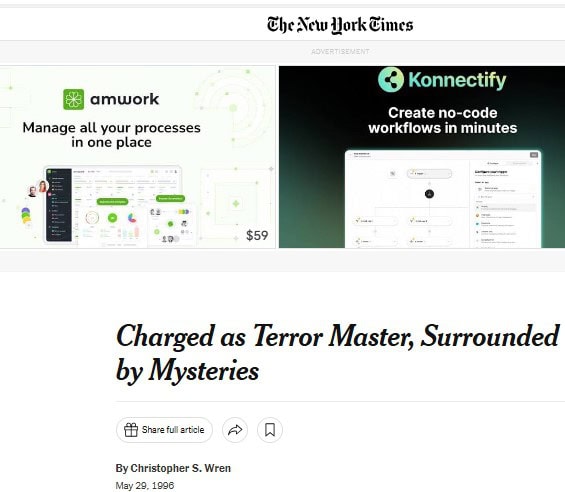
Click Here For Link To Full New York Times Article on Ramzi Ahmed Yousef: Charged as Terror Master, Surrounded by Mysteries – The New York Times (nytimes.com)
Since his arrest in Islamabad, Pakistan, on Feb. 7, 1995, and prompt extradition to the United States, a few details have emerged about Mr. Yousef, who is 28. But less is known about what country or cause, if any, he may have served and where he got the funds that prosecutors say he used to orchestrate bombings from New York to Manila.
In the first statement issued through his lawyer more than a year ago, Mr. Yousef, who is married and has two small daughters, said his real name was Abdul-Basit Balochi and that he came from Pakistan. He also said he had many close relatives in Iraq and Israel as well as “friends and relatives killed in Palestine” by the Israeli Army.
In a 1994 interview with the Arabic newspaper Al Hayat, Mr. Yousef expanded on his Palestinian connections, saying that while his father was Pakistani, his mother was Palestinian and his grandmother lived in Haifa, Israel. He also said that he grew up in Kuwait, where Palestinians have complained of being treated as second-class citizens. News reports described his father as an employee of Kuwaiti Airlines.
A defendant in the current trial, Abdul Hakim Murad, said he knew Mr. Yousef as Abdul Basit when they went to school together in Kuwait’s working-class suburb of Fahaheel. Mr. Yousef left for Britain at age 18 to study at a technical college in Swansea, Wales. He received an electronic engineering degree in 1989 and returned to Kuwait.
Mr. Yousef left Kuwait again in August 1990, three weeks after Iraq invaded. His use of an Iraqi passport and admission to having relatives in Iraq has led to speculation that he worked for Iraqi intelligence. But no harder evidence has surfaced.
In pretrial testimony, Charles B. Stern, an F.B.I. agent, said that on the flight back to the United States after his capture, Mr. Yousef began trying to come up with “some plausible explanation of why his fingerprints would have appeared on certain key locations” in the World Trade Center bombing case. When Mr. Stern began writing the interview down, he said, Mr. Yousef interjected, “No, no, I don’t want you to take notes.”
Mr. Stern testified that Mr. Yousef expected to face the death penalty in the United States. “He indicated that he wanted to be allowed to live long enough so that he could write a book about his activities,” Mr. Stern said. Defense lawyers have sought to disallow Mr. Yousef’s comments on the plane, saying he was never advised of his full rights.
The indictment said that Mr. Yousef and other conspirators plotted and tried to destroy or damage an unspecified number of aircraft under United States jurisdiction. Philippine investigators contended that attacks were planned on 11 planes, many of them jumbo jets, flying to Asian desinations on the same day.
Mr. Yousef was discovered after neighbors detected smoke coming from the Manila apartment where he was mixing explosive chemicals one night in January 1995, investigators said. He escaped, but the police caught Mr. Murad when he went back to get Mr. Yousef’s laptop computer, which the indictment says held departure and arrival times for commercial airliners and detonation times for bombs.
Mr. Murad, who is on trial with Mr. Yousef, has recanted what he told Philippine authorities, claiming he was tortured to confess. The third defendant, Wali Khan Amin Shah, escaped from the Metropolitan Correctional Center on Feb. 6.
Click Here For Full Wikipedia Post on John P. O’Neill: John P. O’Neill – Wikipedia
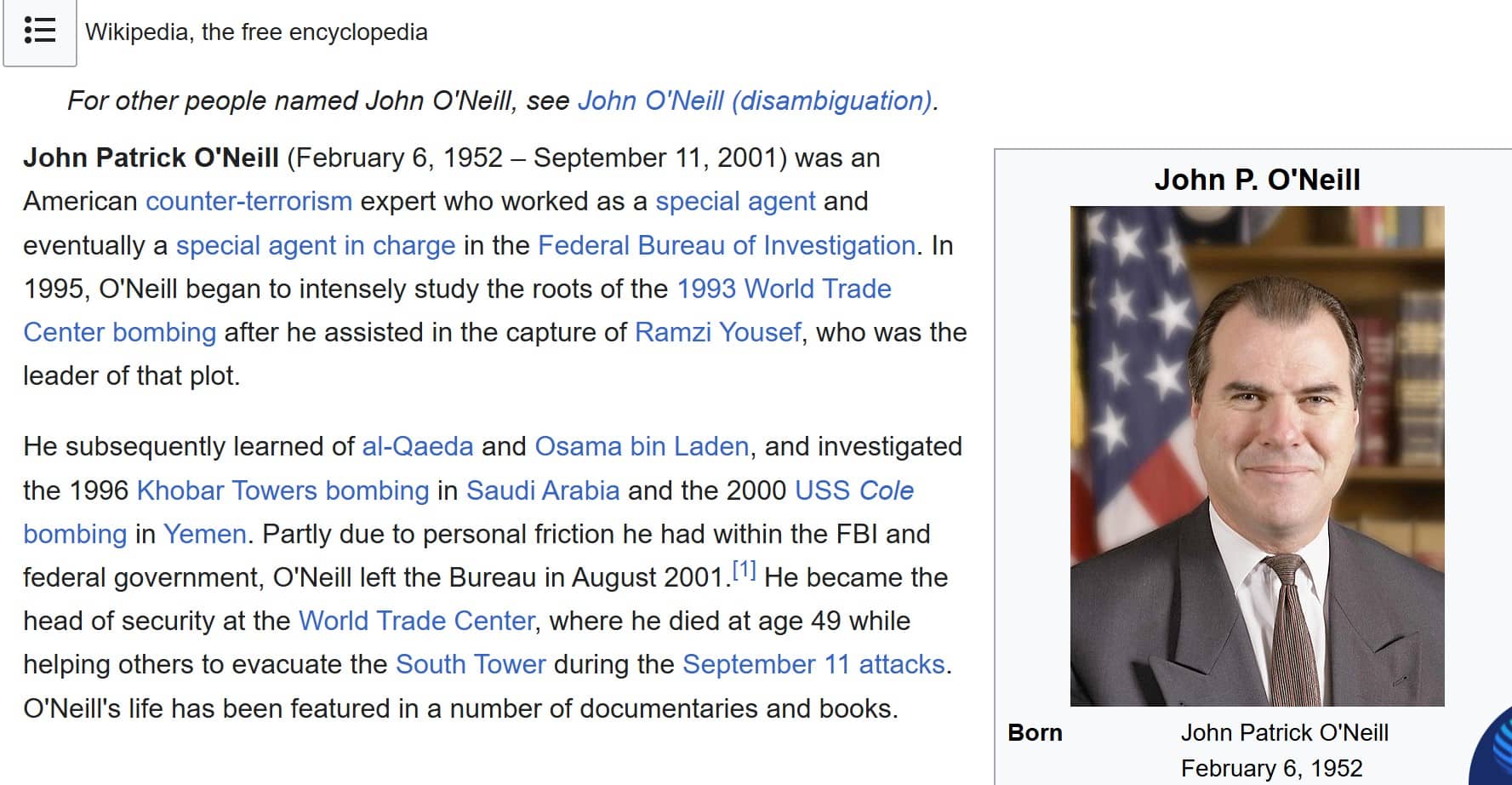
O’Neill was born in Atlantic City, New Jersey, on February 6, 1952. As a child, his favorite television show was The F.B.I.,[1] a crime drama based around true cases the bureau had handled. In 1971, after graduating from Holy Spirit High School, he enrolled at American University in Washington, D.C. While there, O’Neill also started working at the FBI’s Washington headquarters, first as a fingerprint clerk and later as a tour guide.[2]: 198
Career
[edit]
1976–1995
[edit]
The FBI hired O’Neill as an agent in 1976. Over the next 15 years, he worked on issues such as white-collar crime, organized crime, and foreign counterintelligence[1] while based at the Washington bureau. In 1991, he received an important promotion and was moved to the FBI’s Chicago field office, where he was Assistant Special Agent in Charge.[2]: 199 While there, he established the Fugitive Task Force in an effort to promote inter-agency cooperation and enhance ties between the FBI and local law enforcement.[1] In 1994, O’Neill also became supervisor of VAPCON, a task force investigating abortion clinic bombings.[3][4]
1995–1999
[edit]
In 1995, he returned to the FBI’s Washington, D.C., headquarters and became chief of the counter-terrorism section.[5] On his first day, he received a call from his friend Richard Clarke, who had just learned that Ramzi Yousef had been located in Pakistan. O’Neill worked continuously over the next few days to gather information and coordinate the successful capture and extradition of Yousef.[1] Intrigued by the case, O’Neill continued to study the 1993 World Trade Center bombing that Yousef had masterminded and other information about Islamic militants. He was directly involved in the investigation into the June 1996 bombing of the Khobar Towers in Saudi Arabia, which took place during a retreat O’Neill had organized in Quantico for FBI and CIA counter-terrorism agents.[3] Frustrated by the level of cooperation from the Saudis, O’Neill purportedly vented to FBI Director Louis Freeh, saying they were “blowing smoke up your ass,”[1] although Freeh later denied this, claiming they had an excellent relationship.[3]
In 1996 and 1997, O’Neill continued to warn of growing threats of terrorism, saying that modern groups are not supported by governments and that there are terrorist cells operating within the United States. He stated that veterans of the insurgency by Afghan rebels against the Soviet Union‘s invasion in the 1980s had become a major threat.[5] In January 1997, he moved to New York City to be Special Agent in Charge of the FBI’s National Security Division, the FBI’s “largest and most prestigious field office.”[3]
By 1998, O’Neill had become focused on Osama bin Laden and created an al-Qaeda desk in his division.[3] In August 1998, two United States embassies were bombed in quick succession in simultaneous attacks in Nairobi, Kenya, and Dar es Salaam, Tanzania. O’Neill hoped to be involved in the investigation because he had gained a tremendous knowledge of Osama bin Laden’s al-Qaeda terrorist network. He persuaded FBI Director Freeh to let his office handle the case, and prosecutor Mary Jo White later said, “John O’Neill, in the investigation of the bombings of our embassies in East Africa, created the template for successful investigations of international terrorism around the world.”[3]
When his friend Chris Isham, a producer for ABC News, arranged for an interview between bin Laden and correspondent John Miller, Isham and Miller used information put together by O’Neill to formulate the questions. After the interview aired, O’Neill pushed Isham hard to release an unedited version so he could carefully dissect it.
O’Neill’s rise through the ranks at the bureau began to slow as his personal style chafed others. . .
In 1999, O’Neill sent a close associate named Mark Rossini to work in the CIA’s Bin Laden Issue Station in Virginia. O’Neill had a conflict with CIA station chief Michael Scheuer: O’Neill wanted Rossini to stay at the station and feed him information about what the CIA was doing,[7] while Rich Blee, who had been appointed by CIA chief George Tenet to head of the Bin Laden Issue Station,[8][9] wanted Rossini out working in the field. Later, when the Bin Laden Issue Station learned that bin Laden’s associates Nawaf al-Hazmi and Khalid al-Mihdhar were headed to the US with visas, Rossini and his colleague Doug Miller attempted to alert O’Neill, but Blee blocked the message. Mihdhar and Hazmi became two of the hijackers of American Airlines Flight 77 on 9/11.[7]
Following the December 1999 arrest of Ahmed Ressam, O’Neill coordinated the investigation into the 2000 millennium attack plots, described by Richard Clarke as “the most comprehensive investigation ever conducted before September 11th.”[3] O’Neill has been described as having a close working relationship with Ali Soufan.[10]
2000
After two months in Yemen, O’Neill returned to New York. He hoped to go back to Yemen to continue the investigation, but was blocked by Bodine and others; the dispute made the US press.[5] Following threats against the remaining FBI investigators, FBI Director Freeh withdrew the team, on O’Neill’s recommendation, in June 2001.[3]
An August 19, 2001, The New York Times report by James Risen and David Johnston suggested that O’Neill had been the subject of an “internal investigation” at the FBI because O’Neill was responsible for losing a briefcase with “highly classified information” in it, including among other things “a description of every counterespionage and counterterrorism program in New York.” The briefcase was recovered shortly after its disappearance.
The FBI investigation was reported to have concluded that the briefcase had been snatched by local thieves involved in a series of hotel burglaries and that none of the documents inside had been removed or even touched.[11] Several people came to O’Neill’s defense, suggesting that he was the subject of a “smear campaign”.[11] One of O’Neill’s associates later claimed that O’Neill believed the source for the Times story was FBI official Thomas J. Pickard.[12] The Times reported that O’Neill was expected to retire in late August.
O’Neill started his new job at the World Trade Center on August 23, 2001. In late August, he talked to his friend Chris Isham about the job. Jokingly, Isham said, “At least they’re not going to bomb it again”, a reference to the 1993 World Trade Center bombing. O’Neill replied, “They’ll probably try to finish the job.”[3]
Death
[edit]

O’Neill was killed on September 11, 2001, in the collapse of the World Trade Center towers.[13] Wesley Wong, an FBI agent who had known O’Neill for more than twenty years, and was in the command center with O’Neill that had been set up following the North Tower crash, last saw O’Neill walking toward a tunnel leading to the South Tower,[3] likely to assist in that building’s evacuation and gather surveillance footage from the security offices located there.[14][15][16] O’Neill’s body was recovered from the debris of the South Tower on September 21.[13]
O’Neill is buried in Holy Cross Cemetery in Mays Landing, New Jersey.[17]
LibertyAndProsperity.com is a tax-exempt, non-political education organization of roughly 200 citizens who mostly live near Atlantic City, New Jersey. We formed this group in 2003. We volunteer our time and money to maintain this website. We do our best to post accurate information. However, we admit we make mistakes from time to time. If you see any mistakes or inaccurate, misleading, outdated, or incomplete information in this or any of our posts, please let us know. We will do our best to correct the problem as soon as possible. Please email us at info@libertyandprosperity.com or telephone (609) 927-7333.
If you agree with this post, please share it now on Facebook or Twitter by clicking the “share” icons above and below each post. Please copy and paste a short paragraph as a “teaser” when you re-post.
Also, because Facebook, YouTube and other social media often falsely claim our posts violate their “community standards”, they greatly restrict, “throttle back” or “shadow ban” our posts. Please help us overcome that by sharing our posts wherever you can, as often as you can. Please copy and paste the URL link above or from the Twitter share button to the “comments” section of your favorite sites like Patch.com or PressofAtlanticCity.com. Please also email it to your friends. Open and use an alternate social media site like Gab.com.
Finally, please subscribe to our weekly email updates. Enter your email address, name, city and state in the spaces near the top of our home page at Homepage – Liberty and Prosperity. Then click the red “subscribe” button. Or email me at sethgrossman@libertyandprosperity.com or address below. Thanks.
Seth Grossman, Executive Director
LibertyAndProsperity.com
info@libertyandprosperity.com
(609) 927-7333

